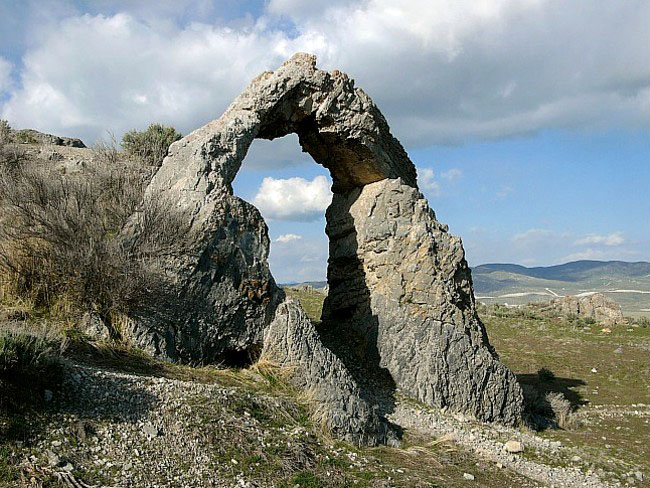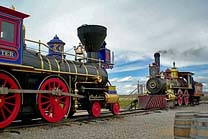|
Scenic USA - Utah Chinese Arch |

| Photo by Scott Dommin Scott Dommin Photography Inset photo by Chris Henn |
Simply stated, America's first Transcontinental Railroad was designed to link the east to the west, and ultimately open the western frontier for settlement. Beginning on 1861, construction camps popped up and then quickly vanished as the train track took shape across the western half of the country. The eastern approach to Utah's Promontory Mountains proved to be exceptionally difficult. Construction workers, under the supervision of the Union Pacific Railroad, were challenged to knock down mountains and fill gaping valleys. Central Pacific crews, bolstered by 10,000 Chinese workers also faced considerable obstacles, having to tunnel through the Sierra Nevada Mountains. The Central Pacific crews, looking for some positive press, laid a record setting ten miles of track across the Utah desert in a 12 hour period.  Using 25,800 rail ties, 3520 rails, and 55,000 spikes, Irish and Chinese crews accomplished a feat that would never be duplicated.
Using 25,800 rail ties, 3520 rails, and 55,000 spikes, Irish and Chinese crews accomplished a feat that would never be duplicated.
The Golden Spike National Historic Site was established to commemorate the completion of this remarkable achievement. Here, the park conveys the dramatic construction story, and marks a point where the two railways joined on May 10, 1869. A mile and a half loop trail leads visitors on a close-up view of Central Pacificís Big Fill and the Union Pacificís Big Trestle. The Promontory Trail Auto Tour covers seven miles of the original Transcontinental Railroad bed. Along the East Auto Tour route, the Chinese Arch was named to honor thousands of Chinese workers brought in to accomplish Central Pacificís portion of the railroad. Originally named Chinaman's Arch, Asian-Americans sucessfully lobbied the U.S. Board of Geographic Names to re-title this Utah natural wonder.
Area Map
Directions - NPS

|
Additional Points of Interest |
|
Copyright © 2020 Benjamin Prepelka
All Rights Reserved
